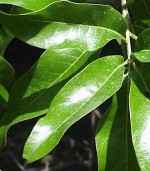 Shingle oak is a deciduous tree native to midwestern and eastern US growing in upland forests and wooded slopes from Pennsylvania to Minnesota, south to North Carolina and Kansas. It is a member of the beech family, Fagaceae, that also includes chestnut. The bark is brownish gray and develops shallow furrows and ridges with age. Unlike most other oaks the leaves are broad and lance- shaped rather than lobed, 4-10 inches long by .6 to 3 inches broad, and resemble laurel leaves. They are glossy green above paler and slightly hairy below, and have smooth margins. In the fall the leaves may be brown or yellow with tints of red and may persist on the tree into winter. Male and female catkins of small greenish yellow flowers appear in spring on the same tree. The female flowers give way to single or paired ¾” long acorns with scaly cups that cover ½ to 2/3 of the nut. The acorns ripen in autumn of the second year and are an important source of food for wildlife including birds and mammals. Shingle oak is a durable tree resistant to breakage and a good choice for a lawn, parking lot, or street tree for the shade it can provide but can be pruned to create a hedge or screen. The generic name Quercus is the Latin name for oak. The specific epithet imbricaria comes from the Latin word imbrex meaning tile. Early settlers in the Midwest used the wood for shingles which accounts for the common name.
Shingle oak is a deciduous tree native to midwestern and eastern US growing in upland forests and wooded slopes from Pennsylvania to Minnesota, south to North Carolina and Kansas. It is a member of the beech family, Fagaceae, that also includes chestnut. The bark is brownish gray and develops shallow furrows and ridges with age. Unlike most other oaks the leaves are broad and lance- shaped rather than lobed, 4-10 inches long by .6 to 3 inches broad, and resemble laurel leaves. They are glossy green above paler and slightly hairy below, and have smooth margins. In the fall the leaves may be brown or yellow with tints of red and may persist on the tree into winter. Male and female catkins of small greenish yellow flowers appear in spring on the same tree. The female flowers give way to single or paired ¾” long acorns with scaly cups that cover ½ to 2/3 of the nut. The acorns ripen in autumn of the second year and are an important source of food for wildlife including birds and mammals. Shingle oak is a durable tree resistant to breakage and a good choice for a lawn, parking lot, or street tree for the shade it can provide but can be pruned to create a hedge or screen. The generic name Quercus is the Latin name for oak. The specific epithet imbricaria comes from the Latin word imbrex meaning tile. Early settlers in the Midwest used the wood for shingles which accounts for the common name.
Type: Deciduous tree
Outstanding Feature: Shade
Form: Conical
Growth Rate: Slow
Bloom: Male and female catkins of small greenish yellow flowers on the same tree in spring
Size: 40-60’ H x 30-60’ W
Light: Full sun
Soil: Fertile, moist, well-drained, acid to neutral
Hardiness: Zones 5-8
Care: Low maintenance
Pests and Diseases: Generally considered pest and disease resistant but susceptible to a wide range of diseases the most significant of which are borer, twig gall leaf minor, oak slug caterpillar, powdery mildew, and oak wilt.
Propagation: Seed